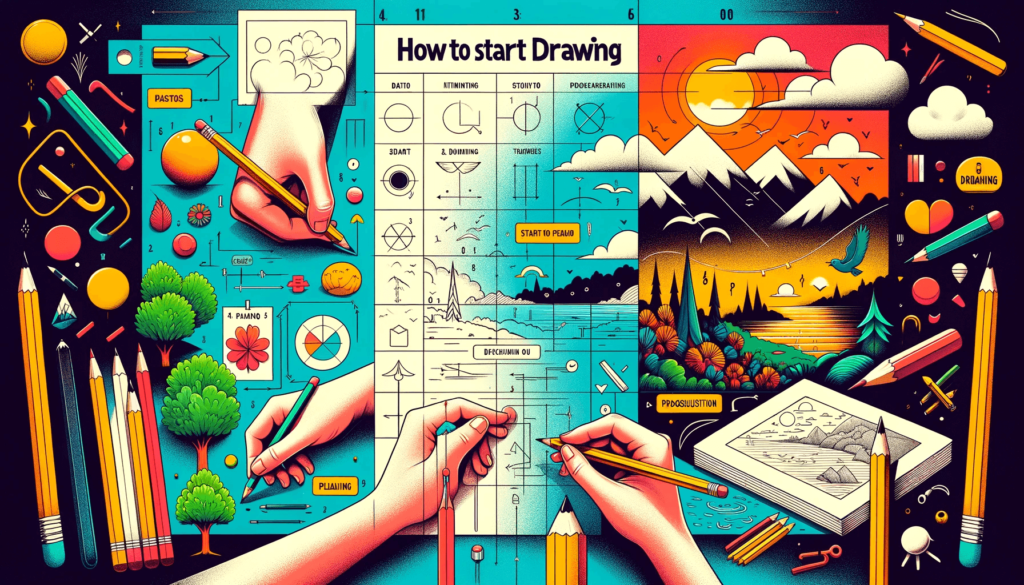
So, you want to start drawing? Great choice! Drawing is not just about making marks on a piece of paper; it’s about expressing yourself, creating something from your imagination, and having a whole lot of fun while you’re at it. Whether you dream of becoming the next big artist or just want to doodle for fun, this guide is your first step into the wonderful world of drawing.
This article is designed for beginners who are interested in exploring the world of drawing but don’t know where to start.
Contents
Key Takeaways:
- Drawing is a skill anyone can learn.
- Start with basic shapes and simple materials.
- Practice regularly and be patient with your progress.
Getting Started
Before we dive into the “how-to,” let’s get something straight: anyone can draw. Yes, that includes you! It doesn’t matter if your current masterpiece is a stick figure; every artist starts somewhere.
Materials You’ll Need
First things first, let’s talk about what you need. Don’t worry; you won’t have to break the bank. Here’s a simple list to get you going:
- Pencil: Just a regular HB pencil will do.
- Eraser: For those little oops moments.
- Paper: Any kind will work, but a sketchbook is handy for keeping all your creations in one place.
That’s it! Told you it was simple.
Basic Shapes and Lines
Now, let’s get down to the actual drawing part. The secret behind most great drawings is starting with basic shapes and lines. It might sound too simple, but trust me, it’s a game-changer.
Start with Simple Shapes
Think about it; everything around you can be broken down into basic shapes. Your favorite cartoon character? A combination of circles, rectangles, and triangles. That cool car you saw the other day? Same deal.
- Circle: Great for heads, wheels, and well, anything round.
- Square/Rectangle: Perfect for buildings, books, and boxes.
- Triangle: Useful for mountains, hats, or even a slice of pizza.
Lines Are Your Friends
Lines can be straight, curvy, wiggly, or whatever you need them to be. They help define the shapes and add details to your drawings. Remember, it’s okay if your lines aren’t perfect. That’s what erasers are for!
Practice Makes Perfect
I know you’ve heard this a million times, but it’s true. The more you draw, the better you’ll get. It’s like learning to ride a bike; wobbly at first, but soon you’ll be cruising along without a second thought.
Set Aside Time to Draw
Try to draw a little bit every day. It could be during a break, while watching TV, or right before bed. It doesn’t have to be a long time; even 10 minutes can make a difference.
Be Patient and Kind to Yourself
Remember, every artist was a beginner once. Your drawings might not look like much at first, but every line you draw is a step towards improvement. Celebrate your progress, no matter how small.
Finding Inspiration
Sometimes the hardest part about drawing is figuring out what to draw. But guess what? Inspiration is all around you!
Look to Your Interests
What do you love? Video games, animals, outer space? Start there! Drawing things you’re interested in makes the process more fun and personal.
Use References
Don’t be afraid to use photos or other artworks as references. It’s a great way to learn and understand how different things look and connect.
Joining the Community
Drawing is more fun when you share it with others. There are tons of online communities and local classes where you can show your work, get feedback, and meet fellow beginners.
Online Platforms
Websites like Instagram, DeviantArt, and Reddit have thriving art communities. You can find tons of tutorials, challenges, and support from other artists.
Local Art Classes
Check out community centers or local art schools for beginner classes. It’s a great way to learn in a structured environment and meet people who share your interest.
Final Thoughts
Starting to draw is like embarking on a fantastic journey. There will be ups and downs, but the important thing is to keep going. Remember, every artist has their own unique style, and there’s no “wrong” way to create art. So grab your pencil, and let’s make some magic happen on paper!
Remember, the key to drawing is to start simple, practice regularly, and most importantly, have fun with it. Who knows, the next sketch you make could be the start of something amazing. Happy drawing!